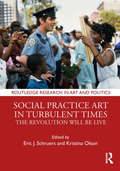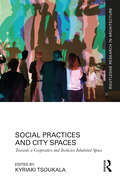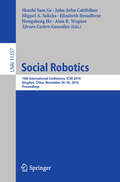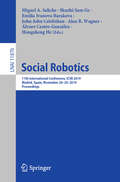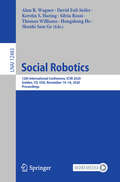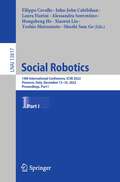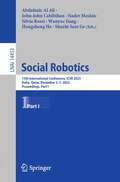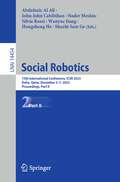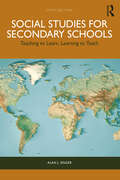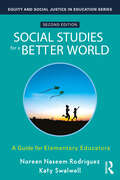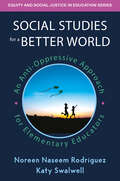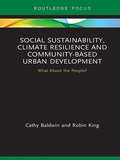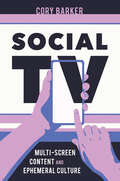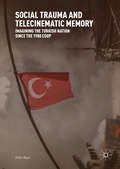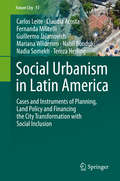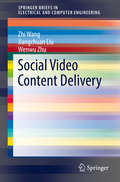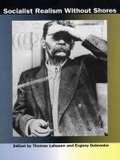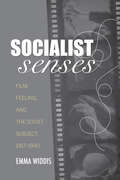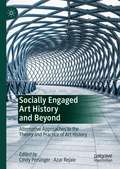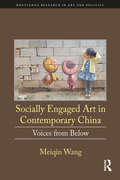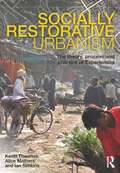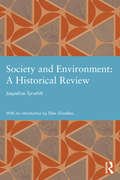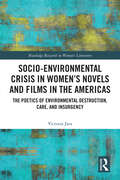- Table View
- List View
Social Photography: Make All Your Smartphone Photos One in a Billion
by Daniela BowkerHot photo apps come and go, but the practice of shooting and sharing is universal and is now a fundamental part of the way that we communicate with each other. Photos aren't printed on paper anymore - they are displayed on screens; and everywhere they are shown, the viewer is invited to like or share. Social Photography will show you how to create photos that will be clicked on, liked, shared, and - if you want - go viral. A must-read for anyone who takes their online presence seriously, this book will show you how to give your photos a fresh look, give you hundreds of posing and shooting ideas, and let you share your life's most exciting moments wider than ever before.
Social Practice Art in Turbulent Times: The Revolution Will Be Live (Routledge Research in Art and Politics)
by Eric J. Schruers Kristina OlsonThis volume is an anthology of current groundbreaking research on social practice art. Contributing scholars provide a variety of assessments of recent projects as well as earlier precedents, define approaches to art production, and provide crucial political context. The topics and art projects covered, many of which the authors have experienced firsthand, represent the work of innovative artists whose creative practice is utilized to engage audience members as active participants in effecting social and political change. Chapters are divided into four parts that cover history, specific examples, global perspectives, and critical analysis.
Social Practices and City Spaces: Towards a Cooperative and Inclusive Inhabited Space (Routledge Research in Architecture)
by Kyriaki TsoukalaThis book examines the relationship between social practices and built space, focusing on current cooperative/participative and posthuman approaches to its production and management. From a social-cultural-and-ecological perspective, it explores the modes of engagement of all factors in the constitutional processes of inhabited space. Throughout this interdisciplinary collection, built space is reconsidered in the light of other schools of thought such as philosophy, anthropology, social sciences and political theories and practices. It covers new ground at conceptual, epistemic and methodological levels, focusing on inhabited space from within the framework of globalisation, biopolitics, cultural changes, environmental crisis and new technologies. Organised into three parts, Parts 1 and 2 focus on the role of architects in the emergence of a new ethos for habitation, as well as the modalities of the inclusion of differences in design, discussing the importance of participation and narrative at a theoretical and practical level in architecture. In the third part, the chapters delve into questions regarding the intersection of design, ecology and technoscience in a posthuman approach, which might support the inclusion of differences in design and the emergence of a new environmental ethos. Providing a stimulating landscape of arguments and challenges to new readings of architecture, society and the environment, this book will be of interest to researchers, students and professionals of architecture, urban planning, anthropology and philosophy.
Social Robotics: 10th International Conference, ICSR 2018, Qingdao, China, November 28 - 30, 2018, Proceedings (Lecture Notes in Computer Science #11357)
by Shuzhi Sam Ge John-John Cabibihan Miguel A. Salichs Hongsheng He Elizabeth Broadbent Alan R. Wagner Álvaro Castro-GonzálezThis book constitutes the refereed proceedings of the 10th International Conference on Social Robotics, ICSR 2018, held in Qingdao, China, in November 2018.The 60 full papers presented were carefully reviewed and selected from 79 submissions. The theme of the 2018 conference is: Social Robotics and AI. In addition to the technical sessions, ICSR 2018 included 2 workshops:Smart Sensing Systems: Towards Safe Navigation and Social Human-Robot Interaction of Service Robots.
Social Robotics: 11th International Conference, ICSR 2019, Madrid, Spain, November 26–29, 2019, Proceedings (Lecture Notes in Computer Science #11876)
by Shuzhi Sam Ge John-John Cabibihan Miguel A. Salichs Hongsheng He Alan R. Wagner Álvaro Castro-González Emilia Ivanova BarakovaThis book constitutes the refereed proceedings of the 11th International Conference on Social Robotics, ICSR 2019, held in Madrid, Spain, in November 2019.The 69 full papers presented were carefully reviewed and selected from 92 submissions. The theme of the 2018 conference is: Friendly Robotics.The papers focus on the following topics: perceptions and expectations of social robots; cognition and social values for social robots; verbal interaction with social robots; social cues and design of social robots; emotional and expressive interaction with social robots; collaborative SR and SR at the workplace; game approaches and applications to HRI; applications in health domain; robots at home and at public spaces; robots in education; technical innovations in social robotics; and privacy and safety of the social robots.
Social Robotics: 12th International Conference, ICSR 2020, Golden, CO, USA, November 14–18, 2020, Proceedings (Lecture Notes in Computer Science #12483)
by Thomas Williams Shuzhi Sam Ge Hongsheng He Alan R. Wagner Silvia Rossi David Feil-Seifer Kerstin S. HaringThis book constitutes the refereed proceedings of the 12th International Conference on Social Robotics, ICSR 2020, held in Golden, CO, USA, in November 2020. The conference was held virtually.The 57 full papers presented were carefully reviewed and selected from 101 submissions. The theme of the 2020 conference is Entertaining Robots. The papers focus on the following topics: human-robot trust and human-robot teaming, robot understanding and following of social and moral norms, physical and interaction design of social robots, verbal and nonverbal robot communication, interactive robot learning, robot motion and proxemics, and robots in domains such as education and healthcare.
Social Robotics: 14th International Conference, ICSR 2022, Florence, Italy, December 13–16, 2022, Proceedings, Part I (Lecture Notes in Computer Science #13817)
by Shuzhi Sam Ge John-John Cabibihan Hongsheng He Filippo Cavallo Xiaorui Liu Laura Fiorini Alessandra Sorrentino Yoshio MatsumotoThe two-volume set LNAI 13817 and 13818 constitutes the refereed proceedings of the 14th International Conference on Social Robotics, ICSR 2022, which took place in Florence, Italy, in December 2022. The 111 papers presented in the proceedings set were carefully reviewed and selected from 143 submissions. The contributions were organized in topical sections as follows: Social robot navigation and interaction capabilities (voice, tactile); Social robot perception and control capabilities; Investigating non verbal interaction with Social robots; Foster attention and engagement strategies in social robots; Special Session 1: Social Robotics Driven by Intelligent Perception and Endogenous Emotion-Motivation Core; Special Session 2: Adaptive behavioral models of robotic systems based on brain-inspired AI cognitive architectures; Advanced HRI capabilities for interacting with children; Social robots as advanced educational tool; Social robot applications in clinical and assistive scenarios; Collaborative social robots through dynamic game; Design and evaluate user’s robot perception and acceptance; Ethics, gender & trust in social robotics.
Social Robotics: 15th International Conference, ICSR 2023, Doha, Qatar, December 3–7, 2023, Proceedings, Part I (Lecture Notes in Computer Science #14453)
by Shuzhi Sam Ge John-John Cabibihan Hongsheng He Silvia Rossi Nader Meskin Abdulaziz Al Ali Wanyue JiangThe two-volume set LNAI 14453 and 14454 constitutes the refereed post-conference proceedings of the 15th International Conference on Social Robotics, ICSR 2023, held in Doha, Qatar, during December 4–7, 2023. The 68 revised full papers presented in these proceedings were carefully reviewed and selected from 83 submissions. They deal with topics around the interaction between humans and intelligent robots and on the integration of robots into the fabric of society. This year the special topic is "Human-Robot Collaboration: Sea; Air; Land; Space and Cyberspace”, focusing on all physical and cyber-physical domains where humans and robots collaborate.
Social Robotics: 15th International Conference, ICSR 2023, Doha, Qatar, December 3–7, 2023, Proceedings, Part II (Lecture Notes in Computer Science #14454)
by Shuzhi Sam Ge John-John Cabibihan Hongsheng He Silvia Rossi Nader Meskin Abdulaziz Al Ali Wanyue JiangThe two-volume set LNAI 14453 and 14454 constitutes the refereed post-conference proceedings of the 15th International Conference on Social Robotics, ICSR 2023, held in Doha, Qatar, during December 4–7, 2023. The 68 revised full papers presented in these proceedings were carefully reviewed and selected from 83 submissions. They deal with topics around the interaction between humans and intelligent robots and on the integration of robots into the fabric of society. This year the special topic is "Human-Robot Collaboration: Sea; Air; Land; Space and Cyberspace”, focusing on all physical and cyber-physical domains where humans and robots collaborate.
Social Studies for Secondary Schools: Teaching to Learn, Learning to Teach
by Alan J. SingerNow in its fifth edition, this popular text for secondary social studies methods courses integrates discussions of educational goals and the nature of history and social studies with ideas for organizing social studies curricula, units, lessons, projects, and activities. Advocating an inquiry and activity-based view of social studies teaching that respects the points of view of students and teachers, it offers systematic support and open, honest advice for new teachers.Based in practice and experience, lesson ideas and materials in the book and online are designed to help new teachers address Common Core learning standards, to work in inclusive settings, and to promote literacy and the use of technology in social studies classrooms. Chapters include highlighted Learning Activities, Teaching Activities, and Classroom Activities designed to provoke discussion and illustrate different approaches to teaching social studies and conclude with recommendations for further reading. Features of the fifth edition include: Activities called "Think it over," "Add your voice to the discussion," "Try it yourself," and "It’s your classroom” at the end of each chapter New topics such as the 1619 Project controversy, Stop WOKE campaigns, academic freedom, and legal restraints on 7–12 teachers New content on teaching literacy, including writing, reading, media, computer, and oral literacies Approaches to teaching advanced placement, international baccalaureate, and dual enrollment classes Multi-disciplinary and project-based teaching that combines history and social studies with the social sciences and other academic disciplines Links to the NCSS 3-C framework Information on becoming a professional leader through involvement in organizations like the NCSS and teacher unions Designed for undergraduate and graduate pre-service social studies methods courses, this text is also useful for in-service training programs, as a reference for new social studies teachers, and as a resource for experienced social studies educators who are engaged in rethinking their teaching practice.This text is supported by online materials, including discussion questions, lesson ideas, and links to lesson materials and activity sheets. You can find the resources here: https://alansinger.net/social-studies-for-secondary-schools/
Social Studies for a Better World: A Guide for Elementary Educators (Equity and Social Justice in Education Series)
by Noreen Naseem Rodríguez Katy SwalwellGiving young people opportunities to grapple with injustices and complex social problems can inspire them to build a better world. In this bestselling book, two experienced social studies educators lay out their vision for an elementary social studies education that will help young people find value in learning about the world as they consider how to make their communities more just, equitable, and healthy.Rodríguez and Swalwell unpack the problems that so often characterize the elementary curriculum—normalization, idealization, heroification, and dramatization—and show how common pitfalls can be replaced with creative solutions. This timely second edition discusses increasingly important topics like book bans and the rise of AI, provides updated research and resources, and includes strategies for teaching anti-oppressive social studies even when circumstances are less than ideal.Whether you’re a classroom teacher, methods student, or curriculum coordinator, this is a book that can transform your understanding of the social studies disciplines and their power to disrupt the narratives that maintain current inequities.
Social Studies for a Better World: An Anti-Oppressive Approach for Elementary Educators (Equity and Social Justice in Education Series)
by Noreen Naseem Rodriguez Katy SwalwellPlan and deliver a curriculum to help your students connect with the humanity of others! In the wake of 2020, we need today’s young learners to be prepared to develop solutions to a host of entrenched and complex issues, including systemic racism, massive environmental problems, deep political divisions, and future pandemics that will severely test the effectiveness and equity of our health policies. What better place to start that preparation than with a social studies curriculum that enables elementary students to envision and build a better world? In this engaging guide two experienced social studies educators unpack the oppressions that so often characterize the elementary curriculum—normalization, idealization, heroification, and dramatization—and show how common pitfalls can be replaced with creative solutions. Whether you’re a classroom teacher, methods student, or curriculum coordinator, this is a book that can transform your understanding of the social studies disciplines and their power to disrupt the narratives that maintain current inequities.
Social Sustainability, Climate Resilience and Community-Based Urban Development: What About the People? (Routledge Focus on Environment and Sustainability)
by Cathy Baldwin Robin KingUrban communities around the world face increased stress from natural disasters linked to climate change, and other urban pressures. They need to grow rapidly stronger in order to cope, adapt and flourish. Strong social networks and social cohesion can be more important for a community’s resilience than the actual physical structures of a city. But how can urban planning and design support these critical collective social strengths? This book offers blue sky thinking from the applied social and behavioural sciences, and urban planning. It looks at case studies from 14 countries around the world – including India, the USA, South Africa, Indonesia, the UK and New Zealand – focusing on initiatives for housing, public space and transport stops, and also natural disasters such as flooding and earthquakes. Building on these insights, the authors propose a 'gold standard': a socially aware planning process and policy recommendation for those drawing up city sustainability and climate change resilience strategies, and urban developers looking to build climate-proof infrastructure and spaces. This book will be of great interest to students and scholars of urban studies, resilience studies and climate change policy, as well as policymakers and practitioners working in related fields.
Social TV: Multi-Screen Content and Ephemeral Culture
by Cory BarkerWinner of the 2023 SCMS Media Industries Scholarly Interest Group Outstanding Book Award sponsored by the Center for Entertainment & Media IndustriesOn March 15, 2011, Donald Trump changed television forever. The Comedy Central Roast of Trump was the first major live broadcast to place a hashtag in the corner of the screen to encourage real-time reactions on Twitter, generating more than 25,000 tweets and making the broadcast the most-watched Roast in Comedy Central history. The #trumproast initiative personified the media and tech industries’ utopian vision for a multi-screen and communal live TV experience. In Social TV: Multi-Screen Content and Ephemeral Culture, author Cory Barker reveals how the US television industry promised—but failed to deliver—a social media revolution in the 2010s to combat the imminent threat of on-demand streaming video. Barker examines the rise and fall of Social TV across press coverage, corporate documents, and an array of digital ephemera. He demonstrates that, despite the talk of disruption, the movement merely aimed to exploit social media to reinforce the value of live TV in the modern attention economy. Case studies from broadcast networks to tech start-ups uncover a persistent focus on community that aimed to monetize consumer behavior in a transitionary industry period. To trace these unfulfilled promises and flopped ideas, Barker draws upon a unique mix of personal Social TV experiences and curated archives of material that were intentionally marginalized amid pivots to the next big thing. Yet in placing this now-forgotten material in recent historical context, Social TV shows how the era altered how the industry pursues audiences. Multi-screen campaigns have shifted away from a focus on live TV and toward all-day “content” streams. The legacy of Social TV, then, is the further embedding of media and promotional material onto every screen and into every moment of life.
Social Trauma and Telecinematic Memory
by Pelin BaşcıThis book explores responses to authoritarianism in Turkish society through popular culture by examining feature films and television serials produced between 1980 and 2010 about the 1980 coup. Envisioned as an interdisciplinary study in cultural studies rather than a disciplinary work on cinema, the book advocates for an understanding of popular culture in discerning emerging narratives of nationhood. Through feature films and television serials directly dealing with the coup of 1980, the book exposes tropes and discursive continuities such as "childhood" and "the child". It argues that these conventional tropes enable popular debates on the modern nation's history and its myths of identity.
Social Urbanism in Latin America: Cases and Instruments of Planning, Land Policy and Financing the City Transformation with Social Inclusion (Future City #13)
by Carlos Leite Claudia Acosta Fernanda Militelli Guillermo Jajamovich Mariana Wilderom Nabil Bonduki Nadia Somekh Tereza HerlingThis book highlights current concepts of Social Urbanism, the contemporary set of multiple and interdisciplinary urban studies that have emerged mainly from the complex realities of Latin American cities. The discussion that follows places special emphasis on public land policy and the innovative urban instruments developed in that region to promote social and territorial inclusion. Critical reflections throughout the pages of this book shed light into the local context of each case-study in order to understand their specific set of challenges and opportunities. Relevant lessons are extracted from the three cities here analyzed, the medium-scale city of Medellin, the large-scale city of Bogota, and the megacity of Sao Paulo, as well as from local innovative experiences in Argentina and Uruguay. These cities underwent promising transformation processes over two decades, applying planning and financing instruments of land policy which have produced significant shifts in the urban development paradigm in the region. The quest for social inclusion has emerged as the common denominator in these cities, awakening growing interest across several fields of urban studies, from public policies and city management to urban law, city financing, urban development, and innovative community participation processes. The book brings implications on urban land policy for transition cities in the Global South. The question of social inclusion in Global South cities is however far from being solved; the analysis presented in this book shows advances and hope, besides a long path still ahead, which can only be faced through a continuous and challenging incremental process. May this book be an incremental step.
Social Video Content Delivery
by Zhi Wang Jiangchuan Liu Wenwu ZhuThis brief presents new architecture and strategies for distribution of social video content. A primary framework for socially-aware video delivery and a thorough overview of the possible approaches is provided. The book identifies the unique characteristics of socially-aware video access and social content propagation, revealing the design and integration of individual modules that are aimed at enhancing user experience in the social network context. The change in video content generation, propagation, and consumption for online social networks, has significantly challenged the traditional video delivery paradigm. Given the massive amount of user-generated content shared in online social networks, users are now engaged as active participants in the social ecosystem rather than as passive receivers of media content. This revolution is being driven further by the deep penetration of 3G/4G wireless networks and smart mobile devices that are seamlessly integrated with online social networking and media-sharing services. Despite increasingly abundant bandwidth and computational resources, the ever-increasing volume of data created by user-generated video content--along with the boundless coverage of socialized sharing--presents unprecedented challenges.
Social Works: Performing Art, Supporting Publics
by Shannon Jackson‘a game-changer, a must-read for scholars, students and artists alike’ – Tom Finkelpearl At a time when art world critics and curators heavily debate the social, and when community organizers and civic activists are reconsidering the role of aesthetics in social reform, this book makes explicit some of the contradictions and competing stakes of contemporary experimental art-making. Social Works is an interdisciplinary approach to the forms, goals and histories of innovative social practice in both contemporary performance and visual art. Shannon Jackson uses a range of case studies and contemporary methodologies to mediate between the fields of visual and performance studies. The result is a brilliant analysis that not only incorporates current political and aesthetic discourses but also provides a practical understanding of social practice.
Socialist Realism without Shores
by Evgeny Dobrenko Thomas LahusenSocialist Realism without Shores offers an international perspective on the aesthetics of socialist realism--an aesthetic that, contrary to expectations, survived the death of its originators and the demise of its original domain. This expanded edition of a special issue of the South Atlantic Quarterly brings together scholars from various parts of the globe to discuss socialist realism as it appears across genres in art, architecture, film, and literature and across geographic divides--from the "center," Russia, to various points at the "periphery"--China, Germany, France, Poland, remote republics of the former USSR, and the United States.The contributors here argue that socialist realism has never been a monolithic art form. Essays demonstrate, among other things, that its literature could accommodate psychoanalytic criticism; that its art and architecture could affect the aesthetic dictates of Moscow that made "Soviet" art paradoxically heterogeneous; and that its aesthetics could accommodate both high art and crafted kitsch. Socialist Realism without Shores also addresses the critical discourse provoked by socialist realism--Stalinist aesthetics, "anthropological" readings; ideology critique and censorship; and the sublimely ironic approaches adapted from sots art, the Soviet version of postmodernism.Contributors. Antoine Baudin, Svetlana Boym, Greg Castillo, Katerina Clark, Evgeny Dobrenko, Boris Groys, Hans Günther, Julia Hell, Leonid Heller, Mikhail Iampolski, Thomas Lahusen, Régine Robin, Yuri Slezkine, Lily Wiatrowski Phillips, Xudong Zhang, Sergei Zimovets
Socialist Senses: Film, Feeling, and the Soviet Subject, 1917–1940
by Emma Widdis&“Widdis&’s rich and fascinating book has opened a new perspective from which to think about the Soviet cinema.&” —Kritika This major reimagining of the history of Soviet film and its cultural impact explores the fundamental transformations in how film, through the senses, remade the Soviet self in the 1920s and 1930s. Following the Russian Revolution, there was a shared ambition for a &‘sensory revolution&’ to accompany political and social change: Soviet men and women were to be reborn into a revitalized relationship with the material world. Cinema was seen as a privileged site for the creation of this sensory revolution: Film could both discover the world anew, and model a way of inhabiting it. Drawing upon an extraordinary array of films, noted scholar Emma Widdis shows how Soviet cinema, as it evolved from the revolutionary avant-garde to Socialist Realism, gradually shifted its materialist agenda from emphasizing the external senses to instilling the appropriate internal senses (consciousness, emotions) in the new Soviet subject.
Socially Engaged Art History and Beyond: Alternative Approaches to the Theory and Practice of Art History
by Cindy Persinger Azar RejaieWhat is socially engaged art history? Art history is typically understood as a discipline in which academics produce scholarship for consumption by other academics. Today however, an increasing number of art historians are seeking to broaden their understanding of art historical praxis and look beyond the academy and towards socially engaged art history. This is the first book-length study to focus on these growing and significant trends. It presents various arguments for the social, pedagogical, and scholarly benefits of alternative, community-engaged, public-facing, applied, and socially engaged art history. The international line up of contributors includes academics, museum and gallery curators as well as arts workers. The first two sections of the book look at socially engaged art history from theoretical, pedagogical, and contextual perspectives. The concluding part offers a range of provocative case studies that highlight the varied and rigorous work that is being done in this area and provide a variety of inspiring models. Taken together the chapters in this book provide much-needed disciplinary recognition to socially engaged art history, while also serving as a springboard to further theoretical and practical work.
Socially Engaged Art in Contemporary China: Voices from Below (Routledge Research in Art and Politics)
by Meiqin WangThis book provides an in-depth and thematic analysis of socially engaged art in Mainland China, exploring its critical responses to and creative interventions in China’s top-down, pro-urban, and profit-oriented socioeconomic transformations. It focuses on the socially conscious practices of eight art professionals who assume the role of artist, critic, curator, educator, cultural entrepreneur, and social activist, among others, as they strive to expose the injustice and inequality many Chinese people have suffered, raise public awareness of pressing social and environmental problems, and invent new ways and infrastructures to support various underprivileged social groups.
Socially Restorative Urbanism: The theory, process and practice of Experiemics
by Kevin Thwaites Alice Mathers Ian SimkinsThe need for a human-orientated approach to urbanism is well understood, and yet all too often this dimension remains lacking in urban design. In this book the authors argue for and develop socially restorative urbanism – a new conceptual framework laying the foundations for innovative ways of thinking about the relationship between the urban spatial structure and social processes to re-introduce a more explicit people-centred element into urban place-making and its adaptation. Focusing on this interplay between humans and the built environment, two new concepts are developed: the transitional edge – a socio-spatial concept of the urban realm; and Experiemics – a participative process that acts to redress imbalances in territorial relationships, defined in terms of the awareness of mine, theirs, ours and yours (MTOY). In this way, Socially Restorative Urbanism shows how professional practice and community understanding can be brought together in a mutually interdependent and practical way. Its theoretical and practical principles are applicable across a wide range of contexts concerning human benefit through urban environmental change and experience, and it will be of interest to readers in the social sciences and environmental psychology, as well as the spatial planning and design disciplines.
Society and Environment: A Historical Review (Studies in International Planning History)
by Jaqueline TyrwhittJaqueline Tyrwhitt (1905-1983) was a British town planner, editor, and educator. This book includes four of Tyrwhitt’s key texts to illustrate how she forged and promoted a synthesis of Patrick Geddes’ bioregionalism and the utopian ideals of European Modernist urbanism, which influenced post-war academic discourse and professional practice in urban planning and design internationally. The key texts reprinted in this book are contributions from the Town and Country Planning Textbook (1950) which was published as an outcome for the Correspondence Course in Town Planning for members of the Allied Forces, which Tyrwhitt ran. It was designed to meet the requirements created by passage of the 1947 Town and Country Act and helped to shape a generation of planning practitioners in the UK and commonwealth countries.
Socio-Environmental Crisis in Women’s Novels and Films in The Americas: The Poetics of Environmental Destruction, Care, and Insurgency (Routledge Research in Women's Literature)
by Victoria JaraThe climate crisis has reached a critical point, necessitating urgent global action. Women’s activism against environmental dispossession in the Americas manifests not only in protests and classrooms but also through artistic filmmaking and writing. This book focuses on the overlooked contributions of women filmmakers and novelists, highlighting how their work reveals the connections between environmental dispossession and various injustices related to gender, ethnicity, age, class, and labor. It demonstrates that contemporary women in the Americas engage deeply with ecological issues, analyzing their representations and identifying common principles across texts. Using an interdisciplinary approach from environmental humanities, gender and Indigenous studies, and film and literary studies, the author compares works from Canada and Latin America. Three poetics emerge: environmental destruction critiques harmful development; care expands notions of reciprocity beyond the human; and insurgency showcases struggles against extractivist models. These works invite readers to understand the complex interconnections of environmental justice within society.

